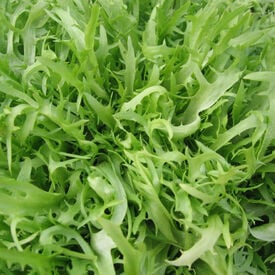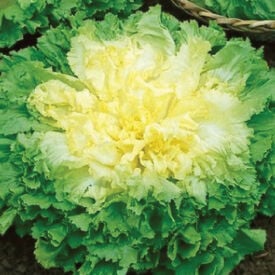The Green Curled Ruffec Endive is an old hardy endive that grows well in cold weather. This variety is a hardy grower in both cold and wet weather. The Green Curled Ruffec Endive has deep cut green leaves that are great for garnishes and salads.
The Salad King Endive lives up to its name, as it is the king of salads! It is a beautiful endive with vigorous and uniform growth. This variety's long, curled and deeply cut leaves have a dark green blade and pale green midrib. The Salad King Endive grows more spreading and is very slow bolting in hot weather while withstanding fall rains and light frost as well.
The Full Heart Escarole 65 is a chicory that grows upright with delicious creamy leaves. This variety has broad smooth dark green leaves that bunch nicely. The Full Heart Escarole 65's dark green head surrounds the creamy yellow blanched centers. This chicory is great as a garnish!
The Tres Fine Maraichere Olesh is an old French heirloom frisée endive that is tres fine! This variety forms a heart of finely cut, frilly leaves that are mildly bitter, and deliciously crispy in gourmet salad mixes. Tie the heads closed one week before harvest to blanch the center to a creamy white color. Tres Fine Maraichere Olesh does best in spring or fall under cooler conditions.
Frisee endive seeds yield a distinctive and attractive leafy green known for its curly, fringed leaves and crisp texture. Frisee, also referred to as chicory or frisée, features a unique appearance with its lacy, yellow-green foliage that adds both visual appeal and a touch of bitterness to salads. The plant forms a loose rosette of leaves that are slightly ruffled and have a crisp bite, making it a popular choice for adding texture and a complex flavor profile to dishes. Frisee endive is valued for its versatility in the kitchen, offering a zesty contrast to sweeter vegetables and fruits. It grows well in cooler weather and is relatively easy to cultivate, thriving in well-drained soil with consistent moisture. This leafy green is also known for its health benefits, being rich in vitamins and minerals while adding a gourmet touch to salads and garnishes.
Broadleaf Batavian endive seeds produce a vigorous leafy green with broad, dark green leaves that add a hearty texture and distinctive, mildly bitter flavor to various dishes. To plant these seeds, start them indoors 6-8 weeks before the last frost or sow them directly into well-drained soil in early spring or late summer for a fall crop. Space the seeds about 12 inches apart, either in rows or as a direct sowing, and plant them ¼ inch deep. If starting indoors, transplant seedlings outdoors once they are 3-4 inches tall and all danger of frost has passed. Broadleaf Batavian endive thrives in cool weather and prefers full sun to partial shade. Keep the soil rich, moist, and well-drained, and provide regular watering to prevent drought stress. The endive grows well in cooler temperatures, making it suitable for early spring or late summer planting. Harvest the leaves when they are young and tender, usually 70-80 days after sowing, by picking the outer leaves or cutting the entire plant at the base. For a continuous supply, sow seeds in intervals, ensuring a fresh harvest of this flavorful green throughout the growing season.






